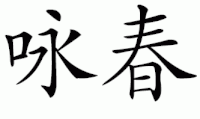Wing Chun
 |
|
 |
|
| Also known as | Wing Cheun, Wing Tsun, Ving Tsun, Wing Tsung |
|---|---|
| Focus | Striking, Trapping |
| Country of origin |
|
| Creator | Ng Mui of the Five Elders |
| Famous practitioners | Donnie Yen, Robert Downey Jr., Leung Jan, Chan Wah-shun, Yuen Kay Shan, , Yip Man,Leung Sheung, Wong Shun Leung, Bruce Lee,Leung Ting, Kenneth Chung |
| Parenthood | Fujian White Crane |
| Descendant arts | Jeet Kune Do |
| Olympic sport | No |
| Wing Chun | |||||||||||||||||||||
| Traditional Chinese | |||||||||||||||||||||
|---|---|---|---|---|---|---|---|---|---|---|---|---|---|---|---|---|---|---|---|---|---|
| Simplified Chinese | |||||||||||||||||||||
| Literal meaning | Spring Chant | ||||||||||||||||||||
|
|||||||||||||||||||||
| Transcriptions | |
|---|---|
| Standard Mandarin | |
| Hanyu Pinyin | Yǒng Chūn |
| Bopomofo | ㄩㄥˇ ㄔㄨㄣ |
| Hakka | |
| Romanization | Yún Chhûn |
| Yue: Cantonese | |
| Yale Romanization | Wing6 Cheun1 |
| Southern Min | |
| Hokkien POJ | Éng-chhun |
Wing Chun (traditional Chinese: 詠春; simplified Chinese: 咏春) is a concept-based Chinese martial art and form of self-defense utilising both striking and grappling while specializing in close range combat.
The earliest known mentions of Wing Chun date to the period of Red Boat Opera (late 1800s).
The common legend as told by Yip Man involves the young woman Yim Wing-chun during the period after the destruction by the Qing government of the Southern Shaolin and its associated temples.
Having rebuffed the local warlord's marriage offer, Yim Wing-Chun said she'd reconsider the proposal if he could beat her in a fight. She soon crossed paths with a Buddhist nun named Ng Mui, who was one of the Shaolin Sect survivors, and asked the nun to teach her to fight. According to legend, Ng Mui taught Yim Wing-Chun a new system of martial art that had been inspired by the nun's observations of a confrontation between a Snake and a Crane. This then-still nameless style enabled Yim Wing-Chun to beat the warlord in a one-on-one fight. Yim Wing-Chun thereafter married Leung Bok-Chau and taught him the style, which was later named after her.
Since the system was developed during the Shaolin and Ming resistance to the Qing Dynasty, many legends, including the story of Yim Wing-Chun, were spread regarding the creation of Wing Chun in order to confuse enemies. This is often given as a reason to explain the difficulty in accurately determining the creator or creators of Wing Chun.
Wing Chun is the most common romanization, from the Cantonese pronunciation (simplified Chinese: 咏春; traditional Chinese: 詠春; Cantonese Yale: Wing6 Cheun1; pinyin: Yǒng Chūn; literally: "Spring Chant"). It is also romanized as Ving Tsun or Wing Tsun, and sometimes the characters are substituted with a homonym (Cantonese Yale: Wing6 Cheun1; literally: "Eternal Spring"). Even though it could be considered a linguistically erroneous romanization at least from English-speaking countries perspective, especially in Finland, Germany and Turkey (and as a commonplace term in some other countries such as Austria, Bulgaria, Italy, Slovakia).
...
Wikipedia
